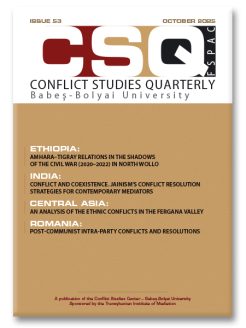
Issue 53 – October 2025
TOPICS: Amhara-Tigray, Jainism, mediation, ethnic conflicts, intra-party conflicts
Coordinator:
Christian Chereji and Ciprian Sandu
Content –Content – Sommaire:

ARTICLES in Issue 53 – October 2025:
Ethiopia: Amhara–Tigray Relations in the Shadows of the Civil War (2020–2022) in North Wollo
Theodros Fisseha ADMASSU & Bamlaku Tadesse MENGISTU
Abstract:
The Amhara and Tigray communities share a strong bond based on geographic proximity, religious affiliation, related means of livelihood, shared cultural practices, and economic interdependence. Yet, the relationship between the two communities has long been affected by power rivalry among their respective elites. The post-2018 politico-economic struggle for control of state power ultimately triggered the onset of the Ethiopian civil war (2020–2022). This article empirically investigates how the territorial expansion of the Ethiopian civil war impacted ethnic relationships between the Amhara and Tigray communities in North Wollo (NW), drawing theoretical insights from theories of ethnicity. Employing primary and secondary qualitative data, the study revealed that the three-decades-long practice of ethnic-based federalism championed by Tigrayan elites engendered ethnic-based affiliation among younger generations, who primarily identified themselves with an ethnic identity. This eventually deteriorated Amhara–Tigray community relations due to three interrelated factors: local violence in NW, factors associated with the 2018 political reform, and the advent and territorial expansion of the Ethiopian
civil war. The civil war, primarily driven by elite interests, resulted in a lack of trust, diminished social
relationships, and growing suspicion between members of the two communities. Unless genuine
people-to-people reconciliation is conducted, the elite-driven rift between the two communities will
further worsen the socio-economic interactions of the local populations.
Keywords:
Amhara–Tigray, ethnic-based administration, ethnic identity, Ethiopian Civil War, TPLF.
DOI: https://doi.org/10.24193/csq.53.1

India: Conflict and Coexistence. Jainism’s Conflict Resolution Strategies for Contemporary Mediators
Ankit ANAND, Ishita CHATTERJEE, M. Shamima PARVEEN, Rajneesh KUMAR, & Gurminder KAUR
Abstract:
This article aims to examine the relatively neglected yet significant role of Jainism, an ancient Indian religion based on the principles of non-violence, in establishing peace through conflict resolution. It explores how fundamental Jain teachings extend far beyond personal spirituality and provide guidance on resolving societal conflicts. The study discusses both historical and doctrinal dimensions, illustrating how Jainism offers clear guidelines for addressing conflicts in a non-violent manner. The article highlights how Jainism promotes a culture of peace through self-restraint, forgiveness, empathetic communication, and non-violence as its cornerstone. In the context of contemporary conflict resolution mechanisms, this study offers an important lesson, particularly for mediators seeking alternative methods that foster long-term peace by integrating traditional practices with philosophical interpretations— approaches increasingly relevant to the sustainable development of harmony. The article also provides pragmatic guidelines, showing how Jain conflict resolution mechanisms can offer profound insights and methods for mediators in today’s world.
Keywords:
Conflict resolution, Golden Rule, Jainism, non-violence, mediation, mediator.
DOI: https://doi.org/10.24193/csq.53.2

Central Asia: An Analysis of the Ethnic Conflicts in the Fergana Valley
Rakhmanali BEKMIRZAYEV
Abstract:
The Fergana Valley, a historically and ethnically diverse region in Central Asia, has experienced multiple ethnic conflicts that have significantly shaped its socio-political landscape. This paper investigates the underlying causes of these conflicts, their socio-economic and political ramifications, and their broader impact on interethnic relations. Employing historical analysis and qualitative research methods, the study examines how both past and contemporary ethnic tensions have affected regional stability. The findings underscore the role of economic inequalities, complex border demarcations, and political dynamics in exacerbating interethnic discord. Additionally, the study explores the impact of migration, resource competition, and national policies on ethnic relations. In addressing these challenges, the paper discusses potential conflict-resolution strategies, emphasizing the need for economic cooperation, equitable governance, and policies that promote social cohesion. Furthermore, it highlights the importance of fostering intercultural dialogue and regional collaboration to mitigate ethnic tensions and ensure long-term stability in the Fergana Valley. By providing a comprehensive analysis, this study contributes to a deeper understanding of ethnic conflicts in the region and offers insights into sustainable solutions for peacebuilding.
Keywords:
Fergana Valley, ethnic conflicts, interethnic relations, socio-political impact, Central Asia, conflict resolution.
DOI: https://doi.org/10.24193/csq.53.3

Romania: Post-Communist Intra-Party Conflicts and Resolutions
Răzvan VOLONCIU, Vladimir RADUȚĂ-GIB, Klaudia MOLNOS, Alexandru SISEŞTEAN, Cosmin Mihai PETRULE, Alexandra FEDIUŞ, & Cosmin Gabriel MARIAN
Abstract:
Over the past thirty-five years, Romanian political parties were alive and abuzz. Also their history for that period was marked by internal ideological heterogeneity, intra-group disagreements, and quite often by open conflicts. Although hard to learn, intra-party conflict management was a necessity for each party organization as, despite contentious internal affairs, each party elite needed to maintain coherence of the overall organisation’s coherence, stabilise membership and be able to campaign coherently in elections. This article examines the two major Romanian political parties that have been in continuous operation since 1990: The Social Democratic Party (PSD – Partidul Social Democrat) and The National Liberal Party (PNL – Partidul Naţional Liberal). It analyses intra-party conflicts in terms of ideological disputes and competition for power with in groups. The conclusions are that despite the turmoil in Bucharest party headquarters, there was a surprising degree of organization stability at the level of each party throughout the period, far greater than ordinarily recognized in the literature or in the op-eds of political pundits.
Keywords:
Party elite conflict, intra-group disagreements, ideological differences, strategic conflict.
DOI: https://doi.org/10.24193/csq.53.4

